|
|
Wolfe Rig
Research by David Weber, Pleasantville, Pennsylvania, provided some of the following information on the popular Wolfe rig. An article on the subject was published by the American Association of Petroleum Geologists in a 1989 guidebook (Pees, ed.)
Linden W. Wolfe, an oil producer in the Oil City area, put together his ideas on a light weight, portable cable tool drilling machine in the opening years of the 20th century. Of course there were a number of makes of portable rigs already on the scene, but Wolfe was rightly positioned in the middle of oil country and was able to quickly cater to local demand. L.W. Wolfe manufactured his Venango Portable Drilling Machines in Sugarcreek Borough, Venango County, Pennsylvania (near Oil City). The drillers simply called them Wolfe rigs. Hundreds were sold and many were used in the Venango County area.
There were two kinds, the regular cable tool drilling machines and the smaller spudder, the latter being used for workovers, clean-outs or drilling the surface hole. The Wolfe rig had a wooden walking beam and a folding wooden ladder-type mast. They were pulled to the well location by tractors or horses. It was said that a Wolfe rig could be set up on a well site in one day. The operator could use steam, gas or gasoline engines to work the rig. A leather belt connected the skid-mounted engine to the drilling machine.
There were two sizes of Wolfe drilling machines. Type A would spool 1200 feet of manila rope. Type B, the largest, could spool 2000 feet of rope. The use of wire cable instead of manila rope would allow extra depth capacity for both types of rigs.
These rigs were sales-pitched with the usual kind of slogans: "The most practical machine for all drilling purposes and cleaning-out purposes." "It will do the work as the work ought to be done."
The development of portable steel spudding and drilling machines such as the Bucyrus-Erie truck rig, eventually made portable wooden walking beam drilling rigs obsolete. L.W. Wolfe continued to build his portable rigs until the great depression of the 1930's. Wolfe rigs can still be found deserted in the early oil belt. Oilmen have told the author fascinating tales of their younger days working on the Wolfe rigs. Those big wooden wheels still make a memorable impression even though the abandoned rigs are slowly sinking and rotting away.
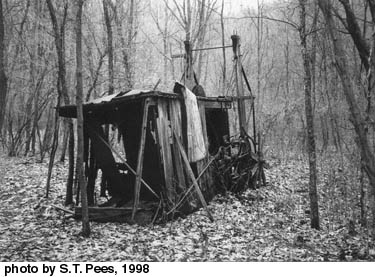 |
This Wolfe spudder (cleaning rig) haunts the woods in Wildcat Hollow. First put into use by the Brundred Oil Company in 1919, after 33 years it passed to Quaker State. The rig was dragged by tractor to this place where it has settled into the ground. There is no sign of a well at this spot.
|
|
| |
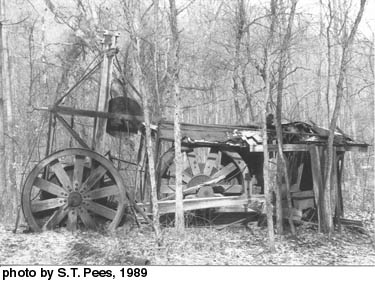 |
Another view of the Wolfe spudder (workover) rig in Wildcat Hollow, Petroleum Centre, Pennsylvania.
|
|
| |
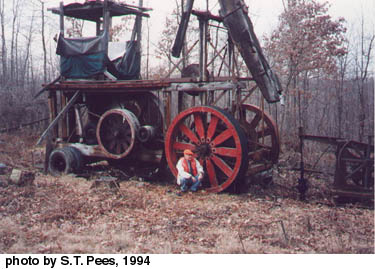 |
This Venango Portable Drilling Machine (Wolfe rig) is in a Venango County oilfield. A hunter has built a blind on the top (turkey or deer). This rig was later moved to the grounds of the Drake Well Museum.
|
|
| |
 |
The Wolfe drilling rig (described previously) set up in the park of the Drake Well Museum, Titusville, Pennsylvania. It was donated by Jon Iftt of Seneca, Pa.
|
|
| |
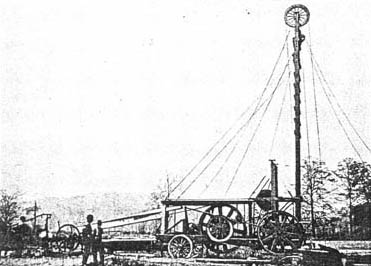 |
Rigging up the two-section mast on a Wolfe rig. This illustration is taken from an instruction booklet put out by Linden W. Wolfe, circa 1916. The mast is a two piece folding ladder type.
|
|
| |
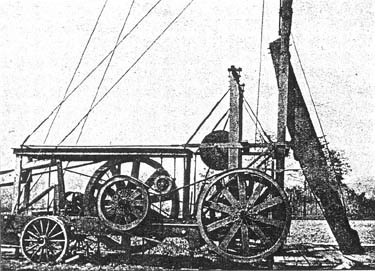 |
Raising the beam of a Wolfe rig. The manufacturer states that the machine operates like a standard rig. From the manufacturer's instruction booklet.
|
|
| |
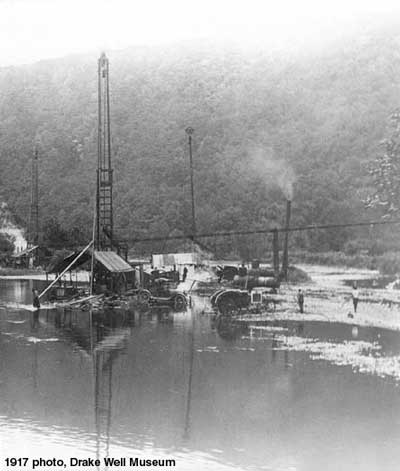 |
Two Wolfe rigs (foreground and left) and a Star rig drilling on gravel bars in Oil Creek at Pioneer, Pennsylvania (now a ghost town, but the wells are still there). A nitro truck has backed up to the foreground Wolfe rig and a Fordson tractor sits on the bar. Locomotive type boilers are fired up. This operation was conducted by the Pioneer Oil Company. 1917 Photo, Drake Well Museum.
|
|
| |
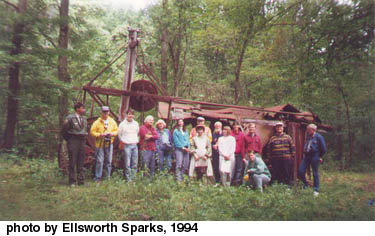 |
Syracuse University Department of Earth Science staff stand together for this photograph at the Wolfe rig in Wildcat Hollow. Doug Finger, Manager of Oil Creek State Park, is at left.
|
|
|

![]()







